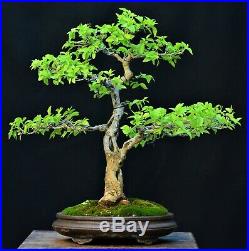
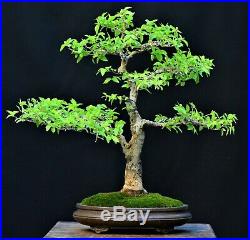
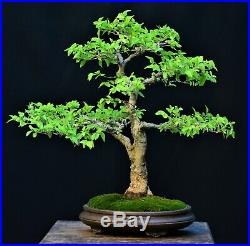
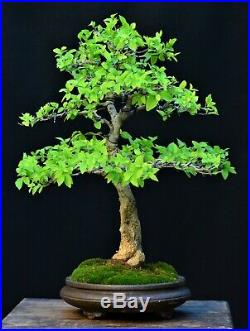
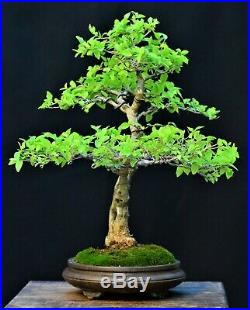
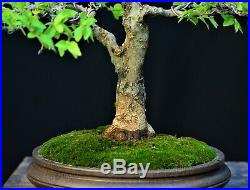
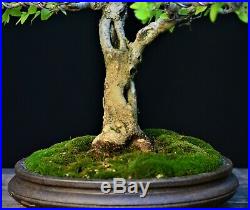
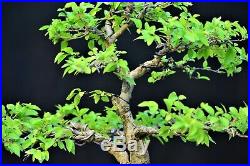
Desert Hackberry (Celtis spinosa, Celtis tala) – Medium size. Height: 16 inches; Width: 18 inches. Pot size 9 X 7.5 X 2 Pot origin: Yixing, China. Trunk/Root base (Nebari): 3.5 inches. Species: Celtis spinosa, Celtis tala Popular name: Desert hackberry, Spiny hackberry, Tala. Depending on the water availability, this tree can take the form of a tall shrub, but can become a medium-sized tree. It’s native range is from Southern-Texas, all the way down to Argentina. Very rare bonsai species. I have never seen exhibited anywhere in California, in the past 22 years. Back in the late 90’s, I. Collected a few seedlings at the Los Angeles County Arboretum. I don’t think that the tree is there anymore. They were planted into my backyard, and grown there for 15 years. It is a semi-deciduous species, here in Southern California. It loses most of the leaves in winter, but not all of them. In a temperate climate, it’s probably best to take them indoors in winter. The branches have a natural zig-zag movement, and the leaves are very small, when grown in bonsai pot. The tree has very fine roots, that results in a great root-base (nebari). It prefers heat, during the growing season, but the roots should not be let to dry out. It is a more feminine, slender tree, with lots of open spaces. It’s well balanced, very nice root-base (nebari), and the trunk has great movement. I really like the gorgeous, shallow pot. I wish had more of them, it has a very unique, stylish look. The tree is styled in the neo-classical style, and looks more like a traditional bonsai tree. This is not a beginner tree, so I do not recommend it for somebody who is just learning the basics of bonsai. The work to be done to take it to the highest level, it needs advanced bonsai knowledge in the area of growing and developing branches. There are a few branches on the upper-half of the trunk, that need to be grown out and thickened. That will take a couple of years of cultivation and styling. Also, a lot of branches still have wires. Some of them (the thick ones) will have to come off this fall. These are on the primary branches. The small wires will have to stay on another year. The new owner will also have to add volume to the foliage pads. Once they fill up, with more ramified tertiary branches, and a couple of branches on the left side grow thicker and longer, the tree will take on a lush, and light-hearted appearance. Additional services offered, free of charge. The item “Desert Hackberry #3 (Celtis spinosa, Celtis tala) bonsai Medium size” is in sale since Tuesday, July 16, 2019. This item is in the category “Home & Garden\Yard, Garden & Outdoor Living\Plants, Seeds & Bulbs\Plants & Seedlings\Bonsai”. The seller is “world_of_bonsai” and is located in Altadena, California. This item can be shipped to United States.
- Foliage: Deciduous
- Type: Deciduous
- Bonsai Species: Celtis spinosa, Celtis tala
- Climate: Warm/Dry
- Indoor/Outdoor: Outdoor/Indoor
- Sunlight: Full Sun
- Plant Form: Advanced bonsai material
- Genus: Celtis
Tags: bonsai, celtis, desert, hackberry, medium, size, spinosa, tala





















0